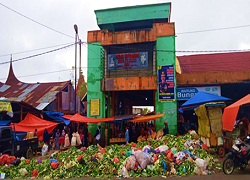REGE (Recycle Vegetable Waste): Pemberdayaan Limbah Sayur Menjadi Pupuk Organik Padat dan Cair Ramah Lingkungan di Pasar Koto Baru REGE (Recycle Vegetable Waste): Empowerment of Vegetable Waste into Environmentally Friendly Solid and Liquid Organic Fertilizer at Koto Baru Market
Main Article Content
Abstract
Compost has some advantages, improving soil physical properties, chemical properties, and biological properties. It happens because its characteristics contain nutrients in varying types and amounts depending on the original material, provide nutrients slowly (slow release) and in limited quantities, and have the main function of improving soil fertility and health. The pile of organic waste from the Koto Baru market directly impacts the environment to their community. This Community Service Program aims to increase the knowledge and skills of target communities about processing vegetable waste from the Koto Baru market into the solid and liquid-friendly environment of organic fertilizers. The target people of this activity were PKK Jorong Subarang Nagari Koto Baru women in particular and people who wrote Jorong Subarang Nagari Koto Baru. The methods used in this service were socialization of the processing of vegetable waste from the Koto Baru market into the solid and liquid-solid and liquid friendly environment of organic fertilizers, distribution of practical manuals for assembling tools for making solid and liquid organic fertilizer from vegetable waste, distributing initial questionnaires to online socialization. This activity had positive impacts on these PKK women, including providing knowledge of PKK women about the use of organic vegetable waste from the Koto Baru market to become a POP friendly environment and POC, the dissemination of information on the use of vegetable waste from the Koto Baru market became a solid and liquid friendly environmental of organic fertilizer in Jorong Subarang Nagari Koto Baru, Tanah Datar Regency.
Downloads
Article Details
Authors who publish with this journal agree to the following terms:
- Any article on the copyright is retained by the author(s).
- Author grant the journal, right of first publication with the work simultaneously licensed under a Creative Commons Attribution License that allows others to share work with acknowledgment of the work authors and initial publications in this journal.
- Authors are able to enter into a separate, additional contractual arrangements for non-exclusive distribution of published articles of work (eg, post-institutional repository) or publish it in a book, with acknowledgment of its initial publication in this journal.
- Authors are permitted and encouraged to post their work online (e.g., in institutional repositories or on their websites) prior to and during the submission process, as can lead to productive exchanges, as well as earlier and greater citation of published work.
- The article and any associated published material is distributed under the Creative Commons Attribution-ShareAlike 4.0 International License
References
Bachtiar, B., Ahmad, A.H. 2019. Analisis Kandungan Hara Kompos Johar Cassia siamea Dengan Penambahan Aktivator Promi. Bioma : Jurnal Biologi Makassar. 4(1):68-76. https://doi.org/10.20956/bioma.v4i1.6493
Ghufron, M.A., Rozak, R.R., Fitrianingsih, A., Matin, M.F., Amin, A.K. 2017. Pelatihan Pengolahan Sampah Organik Menjadi Kompos Dengan Media Keranjang Takakura. J-ABDIPAMAS (Jurnal Pengabdian Kepada Masyarakat). 1(1):98-108. http://dx.doi.org/10.30734/j-abdipamas.v1i1.112
Himawan, N., Kurniawan, D.H., Wahyuni, W., Hidayat, A.M., Supriati, Y., Fauziyyah, A., et al. 2018. Pemberdayaan Masyarakat Dalam Pengolahan Limbah Pertanian Menjadi Briket, Bokashi, Silase, Dan Kompos Cascing. Jurnal Pemberdayaan: Publikasi Hasil Pengabdian Kepada Masyarakat. 1(2):131-136. https://doi.org/10.12928/jp.v1i2.340
Indriyanti, D., Banowati, E., Margunani, M. 2015. Pengolahan Limbah Organik Sampah Pasar Menjadi Kompos. Jurnal Abdimas. 19(1):43–48
Mokodompis, D., Budiman, Balucu, E.P.H. 2018. Efektifitas Mikroorganisme Lokal MOL Limbah Sayuran dan Buah - buahan sebagai Aktifator Pembuatan Kompos. Jurnal Kolaboratif Sains. 1(1):94-103. https://doi.org/10.31934/jom.v1i1.341
Muslimah. 2015. Dampak Pencemaran Tanah dan Langkah Pencegahan. Jurnal Penelitian Agrisamudra. 2(1):11-20. https://doi.org/10.33059/jpas.v2i1.224
Nur, T., Noor, A.R., Elma, M. 2016. Pembuatan Pupuk Organik Cair Dari Sampah Organik Rumah Tangga Dengan Penambahan Bioaktivator EM4 (Effective Microorganisms). Konversi. 5(2):44-51. http://dx.doi.org/10.20527/k.v5i2.4766
Rachman, F., Octalyani, E., Maulana, A., An-Najjah, I.S., Fauzan, N.D. 2021. H2 Super: Inovasi Pupuk Organik Cair dari Sampah Pasar H2, Desa Sido Mukti, Kecamatan Gedung Aji Baru. Altruis: Journal of Community Services. 2(1):4-7. https://doi.org/10.22219/altruis.v2i1.15962
Roidah, I.S. 2013. Manfaat Penggunaan Pupuk Organik Untuk Kesuburan Tanah. Bonorowo : Jurnal Universitas Tulungagung. 1(1):30-42. https://doi.org/10.36563/bonorowo.v1i1.5
